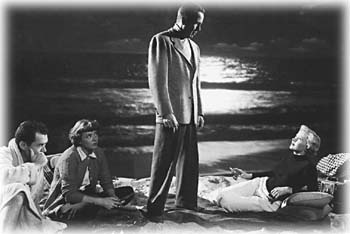![[Metroactive Movies]](/movies/gifs/movies468.gif)
![[Metroactive Movies]](/movies/gifs/movies468.gif)
[ Movies Index | Metro | Metroactive Central | Archives ]
Ray of Hopelessness
 In the Company of Strangers: Humphrey Bogart confronts Gloria Grahame (right) on the beach in Nicholas Ray's "In a Lonely Place." Director Nicholas Ray made repression painfully vivid WHAT CAN ONE conclude about a man who shot a movie in a replica of his own house--and called that movie In a Lonely Place? The title comes from a poem by J.M. Synge, but the sentiment is all Nicholas Ray, cinema's reigning Mr. Vicissitude, whose furious work mirrored the bipolar disorder that tormented him. (One incident from a manic-depressive career: Ray won the Grand Cross of Isabella the Catholic from the Spanish government for making the Jesus movie King of Kings, which he followed up, not many years later, with a satirical porn film titled Wet Dreams.) The double bill of In a Lonely Place (1950) and On Dangerous Ground (1952) offers an excellent introduction to Ray's work. In the former, Humphrey Bogart showed extraordinary range as screenwriter Dixon Steele, 86d from the movie studios for his drinking and his terrible temper. Suffering from "rage that only requires a victim" (Ray's own words), Steele's last human hope is his neighbor, Laurel Gray (Gloria Grahame), an exkept woman trying to retrieve her self-respect. When Steele is accused of a murder, their fragile affair is strained to the breaking point. During the making of In a Lonely Place, Ray was separating from Grahame, his wife at the time, and there's a theory that the atmosphere of loss, of life going haywire, is due to the real-life split-up. Ray's origin in the theater is seen in the inexpensive but compact setting, which was based on the design of his own apartment when he first arrived from New York in lonely California. The sets are bracketed with a bare minimum of exteriors. In this confined lonely place, Bogart--who could be something of an empty threat in his later movies--is dangerous one last time. Ray's trick in this transformation was to make violence violent--in other words, to make Steele's rages not formally introduced with lighting, mood, music and foreshadowing but instead detonating out of nowhere, and with very little warning, as sudden, irreparable shocks. On Dangerous Ground (1952) focuses on a similar helpless rage case: a wound-up city cop named Jim Wilson (Robert Ryan). On his own unofficial blacklist after beating the tar out of a suspect, Wilson is reassigned to a job in the rural part of the state where he meets a blind girl (Ida Lupino) who pulls Wilson out of the crash-course that his life has become. It's scripted by the Fresno pulp novelist A.I. Bezzerides (who also scripted Kiss Me Deadly and They Live by Night); Bernard Herrmann composed the tremendous score. "A hero has to sometimes be shown just as confused or screwed up as you," Ray wrote in notes for a script (quoted in Bernard Eisenschitz's massive Nicholas Ray: An American Journey). This statement sums up exactly Ray's best films from about 19491960, a series of bold, vivid works about repression, in which the characters' bids for freedom are accompanied by fury that's simultaneously justified and unjustifiable. Whether the antiheroes are artists (In a Lonely Place), teachers (Bigger Than Life, 1956), the police (On Dangerous Ground) or the young (Rebel Without a Cause, 1955), Ray's films of the 1950s were all set in the same locale: a closed-in and buttoned-down America--hell with the lid on.
[ Metro | Metroactive Central | Archives ]
| ||||||||||||||||||||||||||||||
This page was designed and created by the Boulevards team.
Copyright © 1997 Metro Publishing, Inc.